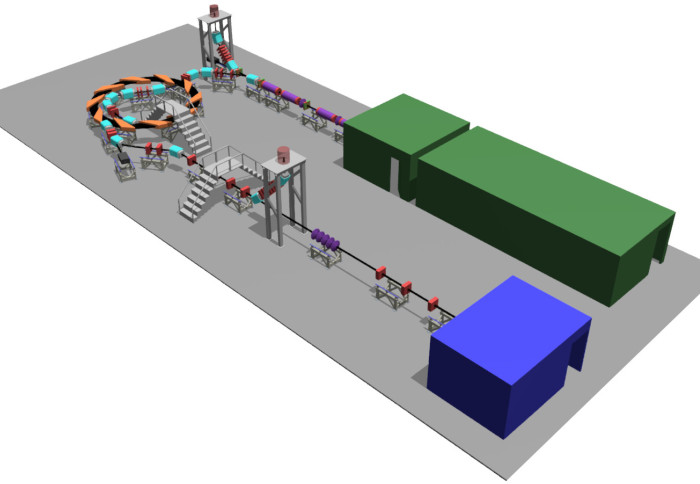Scientists plan new groundbreaking facility to transform UK cancer treatment

Researchers have unveiled designs for a facility intended to make cheaper, more flexible proton beam therapy for cancer treatment a reality.
Clinicians, biologists, physicists, accelerator scientists and other specialists, including those from Imperial College London, are pooling their expertise to design the pioneering radiobiology facility.
As the LhARA initiative continues to gain momentum it is exciting to see the collaboration grow in strength and enthusiasm. Professor Ken Long
The unique collaboration has resulted in a proposal for a Laser-hybrid Accelerator for Radiobiological Applications (LhARA), which aims to investigate how radiation from a proton beam interacts with biological matter when it is used to kill cancer cells, by using a new approach based on high-power lasers.
The facility would also act as a testbed for new machines that would deliver faster and more effective radiotherapy to cancer patients with reduced side effects.
The proposal for the facility is published in Frontiers in Physics: Medical Physics and Imaging.
Targetting tumours
Professor Ken Long, from the Department of Physics at Imperial and the Science and Technology Facilities Council, said: “The multi-disciplinary LhARA consortium pools the expertise of clinicians, biologists, physicists, accelerator scientists, instrumentation specialists, and industrialists. Their dedication and hard work has resulted in the present concept for LhARA. As the LhARA initiative continues to gain momentum it is exciting to see the collaboration grow in strength and enthusiasm.”
Radiation therapy is an established treatment for many cancers. Conventionally, radiation therapy is delivered by machines that accelerate electrons to produce high-energy X-ray beams directed at a tumour to kill cancer cells. However, as the X-ray beam passes through the body, healthy tissue and organs are also damaged.
Machines that accelerate a beam of protons can target their tumour-destroying properties more precisely by depositing nearly all their energy at the site of the tumour, thereby avoiding damage to the tissue surrounding the tumour. The proton machines currently in use are large and extremely expensive and most deliver only one type of ion beam, usually protons (hydrogen) and carbon.
Scientists have been investigating the use of laser-driven proton and ion beams for cancer treatment for some time, as this could greatly reduce the size and cost of the machines and increase its flexibility to deliver a wide range of ion beam species, in a combination that would allow clinicians to deliver the best treatment plan for patients.
How cancer cells are killed
The proposed new facility brings this a step closer by bringing together knowledge and technology from the established accelerator community to help improve and shape the beams from laser accelerators to make them good enough for radiobiology studies. It would use a high-power pulsed laser to accelerate a bright pulse of protons or light ions. The beam is very intense and can be pulsed ten times a second.
As a hybrid accelerator, LhARA would combine established technology with the unique features of a laser accelerator. As a result, LhARA would be able to deliver much higher dose rates of radiation than any other approach currently available, and would be capable of delivering high doses of radiation to multiple labs at the same time, allowing multiple experiments to be performed in parallel.
This design is unique to LhARA and would help researchers discover not just how cancer cells are killed by radiation therapy, but also more about how radiation affects processes in cells such as how they age.
The LhARA consortium will now look to complete the research and development detailed in a five-year plan presented in the pre-conceptual design report for the facility. The execution of this five-year R&D programme will prove the key technologies and deliver the technical design that will allow LhARA to be built.
Imperial’s involvement is coordinated by the Centre for Clinical Applications of Particles (CCAP), an interdisciplinary collaboration of the Faculty of Medicine, the Imperial Academic Health Science Centre, the Imperial College NHS Healthcare Trust, the Department of Physics, the Imperial CRUK Cancer Centre, the Institute of Cancer Research, the John Adams Institute and the Oxford Institute for Radiation Oncology. It develops the technologies, systems, techniques and capabilities necessary to deliver a paradigm shift in the clinical exploitation of particles.
-
‘LhARA: The Laser-hybrid Accelerator for Radiobiological Applications’ by Aymar G et al. is published in Frontiers in Physics: Medical Physics and Imaging.
Based on a press release by the STFC.
Article supporters
Article text (excluding photos or graphics) © Imperial College London.
Photos and graphics subject to third party copyright used with permission or © Imperial College London.
Reporter
Hayley Dunning
Communications Division